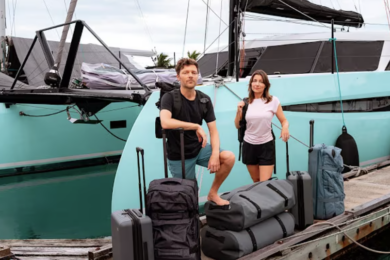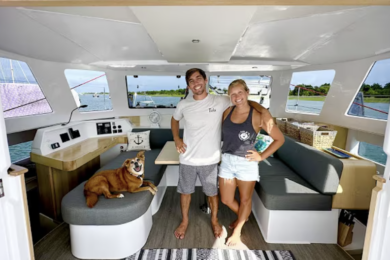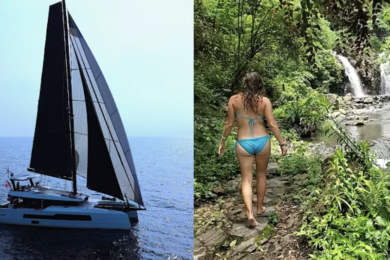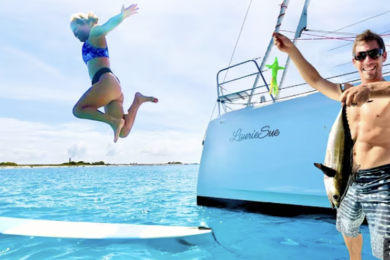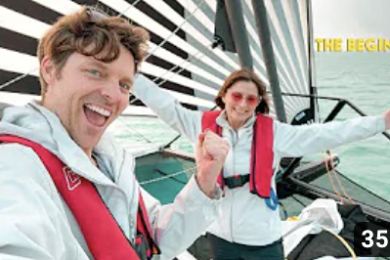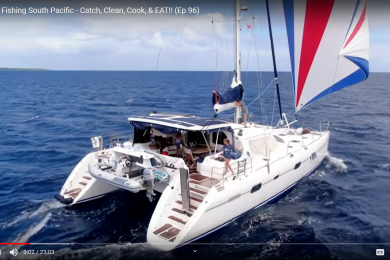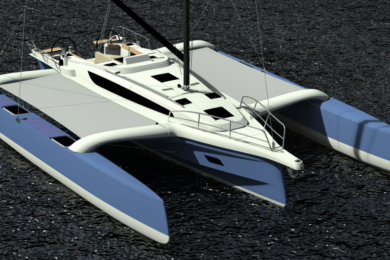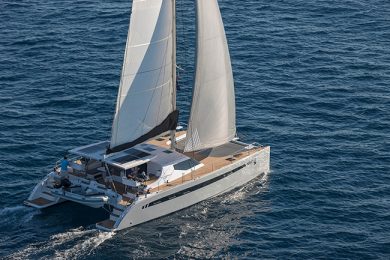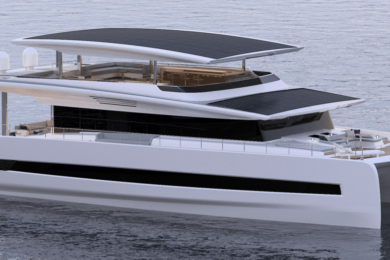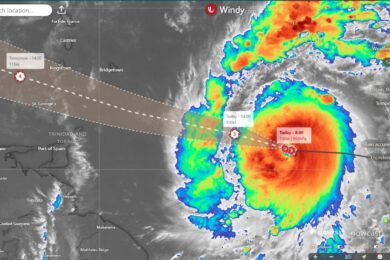This rocket, pocket cruiser adds a touch of comfort to a design that will blow the doors off most other 32 footers (Published Fall 2014)
I met Corsair’s northeast U.S. dealer Bob Gleason (The Multihull Source) at his offices in Wareham, Mass. at the waterfront facilities of the Cape Cod Ship Building Company. The two companies stand as a perfect contrast of opposites.
On the monohull side, C.C.S.B. builds stodgy, old-fashioned full keel designs from the Forties and Fifties that appeal to traditionalists. It was in these types of boats that I first learned to sail.
On the multihull side, Bob is a dealer and broker for some of the world’s fastest and most innovative racer-cruisers—the boats monohull sailors call sailboats with training wheels. That afternoon, we were going trimaran sailing and I was looking forward to having my hair blown back. I wasn’t disappointed.
The all-new Corsair Cruze 970 was moored off Bob’s house at the head of Buzzards Bay and as we rowed out from the beach, the 32-footer tugged at her mooring line and shifted on every puff like a filly itching to gallop.
The 970, like all 2,000 Corsairs built over the last 20 years, is a high tech speed machine that comes with the patented folding amas that allow the boats to be trailered behind a normal car without a special permit. It takes one couple about 30 minutes to transform these boats from a folded up, unrigged trailer rider to a folded out, fully rigged sailboat.
The new boat has thoroughly modern, infused and carbon fiber reinforced hulls and decks and a tall rotating wing mast with a huge square topped main. The slightly overlapping jib is on a roller furling unit and the reacher is fitted to a demountable roller unit that tacks down halfway out the eight foot bow sprit. The asymmetrical spinnaker flies from the end of the sprit but, since it was blowing a steady 15 and gusting over 20 knots, we did not bother to haul out either the reacher or the chute.
With the outboard running on the stern and the sails up, we got away from the mooring and headed out into Buzzard’s Bay. We were soon clear of the mooring field so we shut down the engine and tilted it out of the water. We were sailing.
I have done a fair bit of multihull sailing but mostly on cruising cats that tend to be spacious, comfortable and heavy. That means relatively slow. The exceptions, of course, are the speedsters like the new Gunboat 55 (see last summer’s MQ for the review) and others.
The 970 was a different kettle of fish. We fell off onto a power reach, trimmed the main until the telltales were streaming straight aft, trimmed the jib until the telltales were just right and felt the boat accelerate like a cat with a big dog on its tail. The sensation gave me an adrenaline rush and produced big, silly grins. Yikes. The shore on the far side of the bay was coming at us at an alarming rate.
Bob’s teenaged son was aboard and acted as keeper of the GPS. In that monotone often used by his age group, he announced our speeds. “Ok, 15, 16, 17, 18, 18.5. That’s 18.8.”
The anemometer had the true wind at 18 so we were in fact sailing slightly faster than the wind. You would think that on a 32-footer we would be getting wet. I actually climbed out onto the leeward netting to get the money shot of spray peeling in sheets of diamonds off the leeward bow. But no such luck. I sat there as dry as cactus.
The 970 is based upon the venerable F31 of which 300 were built. That was a truly fine sailing tri that has seen duty in all oceans and even transited the Northwest and Northeast Passages. The 970 has a slightly longer hull and all new amas that have more volume, particularly in the forward sections, that prevents them from burrowing into waves and, to my chagrin, eliminates the sexy bow shot.
The new deck has been raised so there is now full headroom in the saloon and larger windows on both sides. The raised deck also provides a higher bulkhead in the cockpit that makes you feel secure and keeps you dry. The cockpit has been extended aft and two raised seats have been added that provide great visibility forward and a fine place to steer in light weather.
The accommodations are spare when compared to a cat or monohull, but are certainly adequate for cruising. Under the cockpit, a double bunk is accessed through a large deck hatch and ventilated via opening ports. The forward cabin has a V-berth and the head, which can be a Port-a-Potty or a plumbed marine toilet with a holding tank.
The galley is a counter to starboard with a sink and a two-burner stove. The nav station is a counter to port where you can mount instruments, layout charts if you like, and mount your tablet or laptop.

The 970 has a hull draft of only one and half feet so it is easily beachable and can be tucked into tight gunkholes. With the board down, it draws six feet, 10 inches. The board hoists up into a centerboard trunk that bisects the forward end of the cabin. The saloon table attaches to the after side of the centerboard trunk and can be adjusted to be a centerline table or a workstation over the port settee. This all-purpose table can also be mounted in the cockpit in a couple of useful positions.
The sun was getting low but we weren’t ready for sundowners yet. Once we’d crossed the bay at 18 knots, we fell off and broad reached at a sedate 12 to 14 knots down the bay for a while so we would have room for some short tacking on our way home. As we rounded up and trimmed hard, the 970 put her shoulder down a little and began to chew to windward like a performance keel boat. In the 15 to 18 knots of breeze, we didn’t need to reef the main and just depowered a bit with the traveler in the puffs. We found the groove at about 30 degrees apparent with boat speeds that ranged from 11 to 13 knots.


Using the long carbon tiller extension, I crabbed out to the windward ama where I could see forward clearly to get a look at the full mainsail and jib. Bob and his son trimmed and then joined me to windward. The added weight increased our speed by a knot or more. Even better, we weren’t shipping any spray.
Once back on the mooring, we put the 970 to bed for the day and rowed back to the beach in front of Bob’s house. Looking back at the boat, it was amusing to compare it to the several Dough dishes (Herreshof Twelve and Halfs) moored nearby. The old and the new were there side by side. The old was lying peacefully without moving a muscle. The new 970, on the other hand, was tugging at her mooring line and raring to go.
The Cruze 970 is an indication of where the Corsair line is heading. The boat has a little bit more volume and comfort and will be a better cruising boat than the 31. It may be a little heavier than the 31 but it still sails faster than the wind, and that is no small thing in a thoroughly modern cruising boat.
Corsair Cruze 970
LOA 31’10”
LWL 31’10”
Beam 22’7”
Beam (folded) 8’4”
Hull draft 1’5”
Draft CB down 6’10”
Mast height 39’4”
www.corsairmarine.com
www.seawindcats.com

